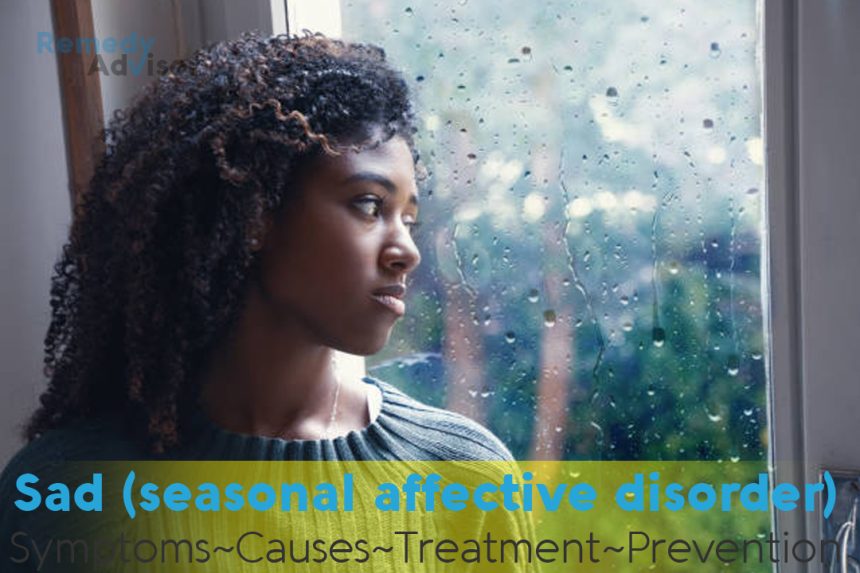What is it
The short dark days of winter cause some people to experience a distinctive type of depression and malaise. SAD, or seasonal affective disorder, as it is now known, is cyclical. In winter, SAD sufferers tend to sleep more, be less productive at work, have less energy for recreation, lose interest in sex, and feel down in the dumps for no particular reason. They tend to eat more (especially sweets and starches). That, together with a low activity level, generally leads to winter weight gain. They may have trouble getting up in the morning, be irritable, and withdraw from friends and family. Children with SAD may do poorly in school.
From around the end of March to the end of October, however, SAD sufferers feel better. Nobody knows how common SAD is, but researchers at the National Institute of Mental Health estimate that it may affect anywhere from 10 to 25 million Americans; at least 80 percent of them are women. Symptoms most commonly start during early adulthood. SAD is thought to be a disorder of the northern latitudes. Oddly, Alaskans and Canadians don’t have higher rates of the disorder than those at lower latitudes. SAD seems to run in families, so there may be a genetic link.
The fact is, SAD symptoms are vague, hard to pin down, and very hard to distinguish from other forms of depression. A definition of SAD has been added to the Diagnostic and Statistical Manual of Mental Disorders (the psychiatric bible): you may have the disorder if you have had fall and winter depression for at least two years, alternating with non-depressed periods during spring and summer; at least one disabling depressive episode; no other major psychiatric disorder; and no other possible explanation for the mood change.
Symptoms
- Depressive periods during fall and winter seasons. Accompanying symptoms include sleeping more than usual; less energy; tendency to eat more, especially sweets and starches; social withdrawal.
- Non-depressed periods during spring and summer.
What causes it
Logically enough, many researchers think that lack of sunlight is at the root of SAD. In general, research has shown that humans have emotional and physiological reactions to changes in the length of the solar day. Daylight is a crucial environmental cue by which humans, like other animals, adapt to the changing seasons and shorter or longer days. Daylight in large part helps to set our circadian rhythms, or biological clocks. But how the lack of light disturbs us remains a mystery. Bright light apparently affects the production of the hormone melatonin, which may influence both our physical and emotional well- being and may set our sleep patterns. Light deprivation may also disturb the secretion of so-called stress hormones, such as Cortisol, which influence how we react to physical and psychological stress.
The belief that light deprivation is behind SAD has led to the development of “light therapy” as one method of treating the condition. Bright, artificial lights are set to emit measured doses of light at a set distance in order to redress the deprivation.
However, recent findings have led researchers to question whether lack of light is indeed the cause of SAD. In fact, according to Dr. Norman Rosenthal at the National Institute of Mental Health (a pioneer in this field and a SAD sufferer himself), “neither the etiology of SAD nor the mechanism of the antidepressant effects of light is well understood.” That is, nobody knows what causes SAD, or why treatment with light improves mood, or if it even does.
What if you do nothing
Because SAD symptoms seem vague and inconsistent, it’s not clear how they evolve over the long term. In some people, symptoms gradually improve over time, while in others they remain the same or get worse. Certainly if you don’t feel better, it’s worth trying the measures suggested below.
Home remedies
If you think you suffer from SAD or some milder form of seasonal depression, here are some commonsense steps you can take during the winter.
Make your house bright
Trim bushes around your windows and keep the curtains open. Use bright colors on walls and upholstery.
Try to sit near a window
If you work in an office and this is an option.
Maximize your daylight time
Get up early.
Get away in winter
Try to take part of your vacation in the winter rather than all of it in the summer. Choose a sunny destination.
Exercise outdoors
Skiing, for example, is an excellent way to get lots of light. If you exercise indoors, try to do so near a window.
If you try light therapy, be cautious
A whole industry has sprung up to produce and sell battery-powered visors, portable light boxes, special light bulbs, and dawn simulators (lamps that switch on before dawn and gradually light your room, like the sun rising).
If the light is too concentrated, as in a halogen lamp, it is more likely to cause headache, eyestrain, or other side effects. Tanning lamps and plant lights are not appropriate, since they emit ultraviolet rays and can cause serious eye damage.







